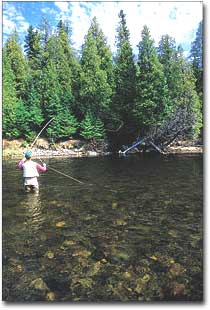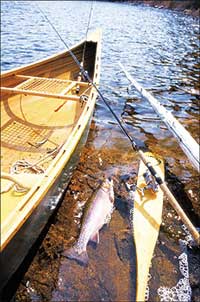Deceiving River Brook Trout
Deceiving River Brook Trout
When I was a boy, fishing meant wading creeks. Dad and I would walk barely discernible forest trails until the sound of rushing water quickened our steps towards cedar-shrouded brookie havens. He would wield his cane fly rod, while I spin-cast to foam-topped pools. The spirited strike of feral brook trout telegraphed volts of pure exhilaration, which only whetted an insatiable appetite. When I learned to handle a canoe, my speckled horizons expanded to larger rivers, where a love for wilderness paddling developed closely behind the quest for trout. I still can't glance at the reckless flow of a wandering river without speculating on the whereabouts of the graceful species.
In choosing a path through an uneven landscape, flowing waters provide ideal quarters for square-tailed trout - not only pan-sized creek specks, but the blue-blooded descendants of the 14 1/2-pound (6.57 kg) world record caught in the Nipigon River. From the big fish in deep, boiling pools of major rivers, to foot-long replicas from diminutive flows, these multi-hued predators are a reflection of their aquatic home. Maybe it's the icy, oxygen-rich water flowing through their gills that makes river specks more aggressive than lake dwellers. The right presentation brings a savage strike and a clear demonstration of why rivers provide the definitive brook trout experience.
 Their propensity to strike means river brookies can be quickly fished down. Some of the best remaining waters are remote, difficult to access, or tough to fish. The prospect of trudging over long portages, wading shallow gravel runs, and running or lining rapids limits the number of people paddling top trout rivers. Similarly, navigating brush-choked shorelines, wading slippery rocks in ice-cold water, and re-tying countless rigs with insect-repellent-soaked hands is not everyone's idea of a good time. In the case of brook trout, however, the calibre of fishing is often equivalent to the resources used in finding and fishing them.
Their propensity to strike means river brookies can be quickly fished down. Some of the best remaining waters are remote, difficult to access, or tough to fish. The prospect of trudging over long portages, wading shallow gravel runs, and running or lining rapids limits the number of people paddling top trout rivers. Similarly, navigating brush-choked shorelines, wading slippery rocks in ice-cold water, and re-tying countless rigs with insect-repellent-soaked hands is not everyone's idea of a good time. In the case of brook trout, however, the calibre of fishing is often equivalent to the resources used in finding and fishing them.
Rivers vary, but spring is often the best time for a brookie excursion. After the seasonal freshet subsides and the murky debris-filled waters clear, river brook trout go on the hunt. Travelling by canoe on many flows is only possible with spring's high water, but in systems with a consistent cold, clean flow, trout continue to hit throughout summer. However, some rivers dry up significantly, and low water and rising temperatures see summer brookies dispersed and hunkered down in deep pools or holed up in lakes or ponds within the system.
If there are brook trout in a river, they're usually easy to find. Water cradled through the rugged topography of brook trout country creates some obvious strongholds. Brookies like cold oxygenated water flowing over their dark hides. While foraging squaretails work fast water, they spend their leisure time lingering in deep pools at the base of falls, rapids, and riffles. In slower sections, cover such as undercut banks, overhanging trees, and submerged logs provides refuge from sunlight and predators, including anglers.
An old pair of running shoes is great for summer "crick walking," but felt-soled waders are the attire for cold-weather trout stalking. When approaching a potential hideaway, bear in mind that brook trout are edgy and easily spooked. Trout grow increasingly wary with age and experience. If you freight-train up to a pool and catch a 14-incher (35.5cm) on the first cast, it doesn't mean the fish weren't spooked, but that you might have missed your chance at a more vigilant speckled elder.
With fish generally facing upstream, there's wisdom in sneaking up behind them by making your way against the current. Travelling downstream is easier, however, especially when paddling, so I embrace the theory that stirring up bottom-dwelling creatures upstream sends hors-d'oeuvres to trigger a feeding frenzy below. This doesn't mean to lumber recklessly along. Stealth is crucial. Keep a low profile, step lightly to minimize vibration, and try not to cast a shadow over the trout zone. If you're in a canoe, drop anchor well above the area you want to fish. Let out slack rope until the current brings you within range of the fish.
Make initial casts count. The longer you spend working an area, the less chance of attracting the vermiculated czar of the pool. Any fish grows suspicious after watching a few comrades get hoisted out of the water. Big specks close their mouths and roll their eyes at the repeated casts of hovering anglers. Once hits dry up, move on to a fresh area.
 Presentation is crucial. Putting an offering in front of trout in a graceful, natural manner means utilizing all variables to advantage. Where to cast, retrieval speed, and lure weight to use depend on water depth, current speed, and where trout are holding. Current is a trout stream's dominant force. Understanding its effect on a bait or lure is the backbone of effective presentation. Use the current as a delivery vehicle by casting upstream and across. The farther upstream you cast, the deeper the bait will run. Tailor retrieval speed to instill action and keep your offering just off bottom, while allowing the current to carry the bait naturally to a suspected brookie bower. In pools and under banks and other cover, opportunistic feeders will snap at what the current brings within attacking distance. While specks can be aggressive, they are suspicious of bait crashing down from above. Don't ignore fast water. When black-hided trout get hungry, they head to riffles to chase minnows, nymphs, leeches, and other tasty organisms. Fan-casting across the current will sweep your lure within range of prowling trout.
Presentation is crucial. Putting an offering in front of trout in a graceful, natural manner means utilizing all variables to advantage. Where to cast, retrieval speed, and lure weight to use depend on water depth, current speed, and where trout are holding. Current is a trout stream's dominant force. Understanding its effect on a bait or lure is the backbone of effective presentation. Use the current as a delivery vehicle by casting upstream and across. The farther upstream you cast, the deeper the bait will run. Tailor retrieval speed to instill action and keep your offering just off bottom, while allowing the current to carry the bait naturally to a suspected brookie bower. In pools and under banks and other cover, opportunistic feeders will snap at what the current brings within attacking distance. While specks can be aggressive, they are suspicious of bait crashing down from above. Don't ignore fast water. When black-hided trout get hungry, they head to riffles to chase minnows, nymphs, leeches, and other tasty organisms. Fan-casting across the current will sweep your lure within range of prowling trout.
Let the river dictate the bait. In tight quarters, specks respond best to live-bait presented on short casts or simply dunked in a pool. Simplicity rules in snag-ridden waters. No. 8 to 12 hooks and a selection of split-shot sinkers are easy to carry and inexpensive to replace. Small garden worms are a standby bait, but just about any organism such as insects, worms, minnows, grubs, or crustaceans found in or along the river works well on a hook.
Where snags are less prevalent, jazz up live bait with an in-line spinner tied three or four inches up from the hook. Even a night crawler presented on a harness is an effective and inexpensive enticement. Artificial lures enter when there is more room to cast and retrieve. Bucktail jigs are great for plumbing deep runs and pools. Spinners like No. 0 to No. 3 Mepps, Blue Fox, Double Loon, E.G.B., and Panther Martin are deadly run clean or tipped with live bait. Tight-wiggling 1/4- to 3/8-ounce spoons like Little Cleos, E.G.B. Blinkers, and Blue Fox Pixies rule larger flows. Trout plying fast water strike aggressively at minnow baits pulled across or against the current. Try 2- to 3 1/2- inch Rapalas, A.C. Shiners, Rebel minnows, or the like. Hot brookie colours include combinations of gold, silver, red, black, and blue. Occasionally, white or green are preferred.
Rods should match the river. Three-foot "brushin" rods are great for plucking pan-sized brookies from alder-choked streams. Eight- or 9-foot light-action steelhead rods are suited to big-river trophies. What is universal is 4- to 6-pound-test line and the smallest snaps and swivels available. In healthy systems it can be easy to catch a limit of brook trout, but trout-filled rivers are a precious resource, easily abused by those solely concerned with showing off a heavy stringer. Harvest their bounty sparingly. Bending barbs down and gentle handling with wet hands increases the chance that delicate trout to be released will be unharmed. Next time they might be a little wiser and a little bigger, but most importantly, they'll be there to ensure our sinuous tracts of flowing water continue to be graced with promise at every turn.
This article is written with permission by Fish Ontario. Visit their website, http://www.fishontario.com, for more Ontario fishing information.
Fish Ontario
|
